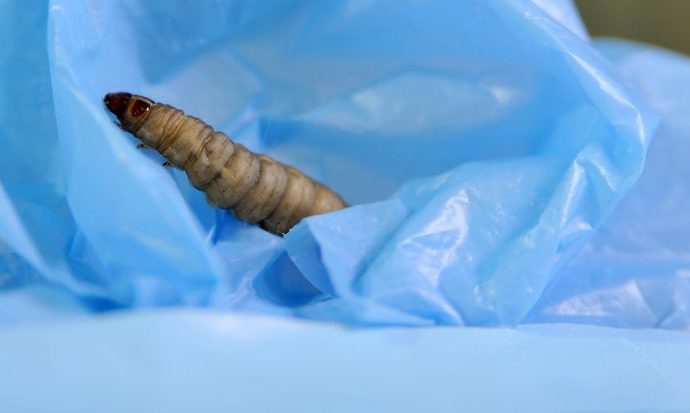Plastic bags need hundreds of years to biodegrade, but wax worms break them down in no time.
Used primarily for disposable packaging like shopping bags and soda bottles, polyethylene is one of the most common plastics. It’s also notoriously slow to break down after it’s made its way into a landfill. But the authors of a new study may have stumbled on a way to significantly speed up the process: a common caterpillar known as the wax worm.
The initial discovery was made not in a lab, but at the home of Federica Bertocchini, a researcher at the Spanish National Research Council. An amateur beekeeper, Bertocchini found a wax worm infestation in some of her beehives. “In cleaning the beehives, I put the worms in a plastic bag,” she explained. “After a short while, they had escaped, and the plastic bag was full of holes.”

Bertocchini immediately began wondering what happened to the parts of the bag the worms had chewed away. She and coauthors Paolo Bombelli and Chris Howe had already been thinking for some time about ways to accelerate plastic’s biodegradation. “We started moving right away. When we saw the holes, we thought that this could actually be a real possibility,” said Bertocchini. The researchers confirmed that the worms’ digestion process was breaking down the plastic, breaking polyethylene’s chemical bond and converting it to ethylene glycol, an organic compound used in the production of polyethylene that itself biodegrades in a few weeks.
Normally, a flimsy polyethylene bag would take over 100 years to break down. A sturdier one could stick around for up to 400 years. With over a trillion plastic bags used each year, this waste is piling up fast. “Plastic is a global problem. Nowadays waste can be found everywhere, including rivers and oceans,” said Bertocchini. It’s even made its way to remote parts of the Arctic, where it’s trapped by ocean currents.
Other methods for breaking down polyethelene, which use corrosives like nitric acid or certain bacteria, take months to work. By contrast, 100 wax worms can biodegrade 92 milligrams of polyethylene in a mere 12 hours. “We do not know how wax worms developed this ability, but it might be that they evolved such a mechanism because they eat wax,” explains Bertocchini. “Wax and polyethylene have a similar chemical structure.”

If the idea of millions of worms eating their way through your local landfill makes your skin crawl, you needn’t worry—the researchers aren’t planning to use the worms themselves to get rid of plastic waste. Instead, they intend to delve deeper into the chemistry wax worms use in order to replicate it in a lab. “There is the possibility that one molecule could do this, so the idea would be to isolate it and reproduce it at a large scale, and use this to degrade the plastic waste,” said Bertocchini.
Bertocchini says this will be her focus next. “Nature is amazing,” she added. “Looking around us, we found solutions.”
Source: Research Gate

































Leave a Comment
You must be logged in to post a comment.